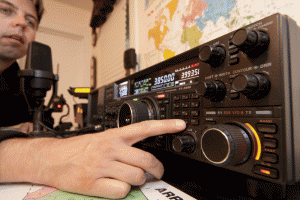Posted: 2 hours ago

We take communication for granted because if we want to talk to someone we have multiple ways of contacting them:? home phones, cell phones, email, and instant messaging.? We are used to instant gratification by calling or texting and pretty much getting an immediate response from virtually everyone on our contact list.? But after all the electronic infrastructure is gone, how will we get in contact with people?? Cell phones, landlines, and the internet will be useless. ?However there are multiple radio options.? Which ones will be of the best use and which ones will be basically useless?
General Mobile Radio Service (GMRS), Family Radio Service (FRS) and Multi-Use Radio Service (MURS) use basic handheld radios that are available commercially with pre-programmed?frequencies.? The person responsible for the GMRS radio must be licensed by the FCC, while FRS and MURS users do not require a license.? These are all basically high end walkie talkies.? The upside:? easy to use, inexpensive and requires no training.? The down side:? there are only 23 channels on GMRS, 14 on FRS and 5 on MURS and when all other forms of communications are unavailable they will be overloaded and basically useless.? Another drawback is that they are basically line of site communication only.? In other words, you will have to be very close to who you want to speak to for them to hear you.
Citizen Band (CB) is a step up from the previously mentioned radio communication possibilities.? CB radio is easy to use and requires no training or license.? CB allows communication on 40 pre-programmed?frequencies.? Like the other radio options the major problem is with the limited number of frequencies, they will be overloaded. ?Range is also limited to around 2 to 5 miles.
The GMRS, FRS, and MURS systems are only useful for small groups to communicate with each other while they are in proximity of each other.? They are not useful to communicate with other groups or people outside your immediate area.? CB radio falls in the same category.? Other forms of radio communications which are utilized by police, fire, EMS and military require outside equipment such as repeaters and infrastructure to operate properly.? In other words the radio is rather useless without the other equipment that you have no control over (or might not be able to acquire).
Amateur Radio (Ham) provides users with the most versatility when considering post SHTF communication scenarios.? The positive aspects of Ham radio are many: ?there are no pre-programmed?frequencies, a Ham operator can program the frequencies of their choice. ?Sure in a functioning government you may only transmit on certain frequencies but after T-SHTF an experienced Ham operator may use any frequency they wish.? Other pros:? range is unlimited, many Ham operators contact people around the world and you can pick up weather channels and short wave frequencies.? The downside:? an FCC license is needed, users much pass a written test to prove they are worthy. ?Additionally equipment is more expensive.
You may be thinking that you won?t need a license if T-SHTF, and that you?ll just buy a Ham radio and use it when the time comes.? You can do that but like other survival skills you need to practice in order to be proficient.? You will need experience in the use of the radio, building antennas, Morse Code and fine tuning of frequencies.? By getting an Amateur Radio License you can also network with other Hams and become familiar with ?Best practices? in Ham operation.? Hams are well versed in making home made antennas that work better then commercial antennas and even building radios.? These are skills that can be learned but it does take time.
A Ham radio operator can function effectively without the use of any other equipment, even though operators do frequently use repeaters on a day to day basis.? Another great aspect of Ham radio is this: you can do more then use voice communication.? Morse Code is a common form of communication in Ham radio.? Also operators commonly utilize ?packet radio?.? Packet radio allows transmission of photos, video, and text.? The text was the predecessor to email.? Yes indeed, Ham radio operators were using email before you were and all these forms of communications are available with just a radio.
Ham radios are versatile and can be base stations located in your home with high output power, mobile mounted in a vehicle with moderate output power, or portable small handheld radios with low power output that can be carried anywhere.
After T-SHTF communication will be difficult but needed. ?Land lines, cell phones, email, instant messaging, and the internet will be lost but Ham Radio will still be there.? When natural disasters like Katrina or Sandy strike, Ham Radio is there to allow emergency personnel to communicate because the normal communications channels are lost. ?When the government can?t communicate with each other during disaster, who do they call for help?? Amateur radio operators, because they know amateur radio is there and works when all other forms of communications fail.? That leads me to believe that after T-SHTF, Ham Radio will be the only form of communication available.
This post was contributed by JM, a certified Paramedic who is also a local EMS Coordinator. ?Look for more posts from him in the future. ?For more information on how to obtain a Ham Radio license check the ARRL Website for details.
*** This article appears courtesy of Prepper-Resources.com, one of the premier prepper/survival blogs online today. Whether you are a new or experienced prepper feel free to visit and check out all of the other valuable information posted there.
Related Posts:
Source: http://usahitman.com/hrofocad/
reba mcentire acm awards the killing april fools global payments eli young band wrestlemania
No comments:
Post a Comment